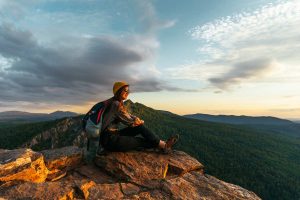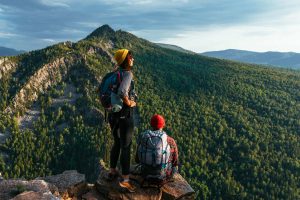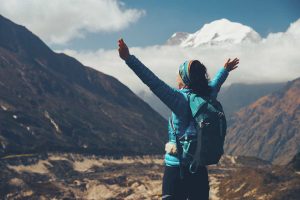Backpacking is an outdoor activity in which people carry all the necessary supplies for an extended hike on their back. It usually involves camping and trekking through wild areas over long distances. Backpacking offers a unique opportunity to explore nature, make new friends, and challenge yourself physically and mentally. There are many benefits of backpacking such as improved physical fitness, stress relief, enhanced appreciation of nature, increased self-reliance, and greater mental clarity.
The best backpacking routes in the U.S., while varied in difficulty level, provide some of the most rewarding experiences available to hikers today. These trails offer stunning vistas, diverse wildlife encounters, challenging terrain changes as well as opportunities for spiritual growth and reflection along the way.
In this blog post we will cover some of the top backpacking routes throughout the United States including John Muir Trail in California; Appalachian Trail from Georgia to Maine; Continental Divide Trail from Montana/New Mexico; Pacific Crest Trail from Oregon/Washington.
John Muir Trail, California
The John Muir Trail is one of the most iconic backpacking routes in the United States. Spanning 220 miles from Yosemite Valley to Mount Whitney, this breathtaking trail passes through some of the most stunning high alpine scenery in California.
Maximum elevation reaches 14,505 feet and hikers can experience a variety of terrain changes from lush meadows and valleys to rugged mountains and glaciers. Along this route you will find an abundance of wildlife including deer, marmots, black bears, coyotes, pikas and more!
There are plenty of activities for all levels including camping by pristine lakes or rivers; bird watching; taking photos at awe-inspiring lookouts; fishing for trout; or simply enjoying nature’s beauty.
Highlights and Activities
In addition to the abundant wildlife, the John Muir Trail is known for its diverse range of terrain changes. The trail winds through lush meadows, thick forests, roaring rivers, and high alpine passes with views of jagged peaks in every direction.
Along this route you will find plenty of opportunities to explore nature such as camping by pristine lakes or rivers; bird watching; taking photos at awe-inspiring lookouts; fishing for trout; or simply enjoying nature’s beauty.
Hikers should also be sure to take advantage of any nearby side trails that lead off from the main path which may be even more rewarding than the original trek itself!
Weather Considerations
The John Muir Trail is located in California’s Sierra Nevada Mountains, so weather can vary widely depending on the time of year. Summertime temperatures can reach into the high 90s during the day, and nighttime lows may dip as low as 10-20 degrees Fahrenheit.
Snow is also possible throughout the spring and early summer months, so hikers should always be prepared for any type of weather when planning their backpacking trip. Rainfall is typically minimal, but thunderstorms are possible in some areas which could create dangerous conditions on exposed trails so it’s important to check forecasts before starting your journey!
Appalachian Trail, Georgia to Maine
The Appalachian Trail is the longest hiking-only trail in the United States. The route stretches for 2,190 miles from Springer Mountain in Georgia up through Maine’s Katahdin Mountain. This trail is well known for its stunning views of the Great Smoky Mountains and beautiful forests along the entire path.
Hikers will enjoy a variety of terrain changes ranging from rolling hills to tall peaks as they make their way through 14 states over six months or more! Along this route you may find an abundance of wildlife such as black bears, deer, wild boar and even cougars so it’s important to stay aware at all times when venturing into these areas.
Highlights and Activities
The Appalachian Trail offers an array of activities and experiences for all levels. Whether you’re a beginner or experienced hiker, there are plenty of opportunities to explore nature.
Highlights along this route include camping in lush forests; fishing at riverside campsites; bird watching in remote meadows; taking photos at stunning vistas; or simply enjoying the peacefulness that comes with being surrounded by nature.
There are also many side trails off the main path which can take hikers to even more spectacular locations when combined with the original trek!
Weather Considerations
The Appalachian Trail can experience a wide range of weather conditions. Summertime temperatures can reach into the high 80s during the day, while nighttime lows may dip down to 30-45 degrees Fahrenheit.
Hikers should take caution when planning their backpacking trip as thunderstorms and other dangerous weather events are common in this area. Snow is also possible throughout the spring months so it’s important to check forecasts before beginning your journey!
Continental Divide Trail, Montana/New Mexico
The Continental Divide Trail is one of the longest and most challenging backpacking routes in the United States. Spanning 3,100 miles from Canada to Mexico through five states, this trail passes through some of the most stunning scenery in North America.
Hikers will experience a variety of terrain changes along this route ranging from lush forests and meadows to high alpine passes with views of towering mountains and glacial lakes. Along this trail you may find an abundance of wildlife such as bighorn sheep, mountain goats, elk and more!
Highlights and Activities
The Continental Divide Trail offers an array of activities for all levels. Highlights along this route include camping in wild forests; fishing at riverside campsites; bird watching in remote meadows; taking photos at stunning vistas; or simply enjoying the peacefulness that comes with being surrounded by nature.
There are also many side trails off the main path which can take hikers to even more spectacular locations when combined with the original trek!
Hikers should be sure to research areas ahead of time as some sections may have restricted access due to dangerous wildlife, extreme weather conditions, and changing terrain.
Weather Considerations
The Continental Divide Trail passes through several states and can experience a wide range of weather conditions. Summertime temperatures can reach into the high 80s during the day, while nighttime lows may dip down to 30-45 degrees Fahrenheit.
Hikers should take caution when planning their backpacking trip as thunderstorms and other dangerous weather events are common in this area. Snow is also possible throughout the spring months so it’s important to check forecasts before beginning your journey!
Pacific Crest Trail, Oregon/Washington
The Pacific Crest Trail is a 2,650-mile-long trail that stretches from Mexico to Canada through California, Oregon and Washington.
This route passes through some of the most stunning scenery in the western United States including lush forests, meadows full of wildflowers, high alpine passes with views of jagged peaks and glaciers. Along this trail you may find an abundance of wildlife such as deer, elk, bears and more!
Highlights and Activities
The Pacific Crest Trail offers multiple activities for all levels along its route. Highlights include camping in wild forests; fishing at riverside campsites; bird watching in remote meadows; taking photos at awe-inspiring lookouts; or simply enjoying nature’s beauty among towering mountains and glacial lakes.
There are also many side trails off the main path which can take hikers to even more spectacular locations when combined with the original trek! Hikers should be sure to research areas ahead of time as some sections may have restricted access due to dangerous wildlife or changing terrain conditions.
Weather Considerations
The Pacific Crest Trail passes through several states and can experience a wide range of weather conditions. Summertime temperatures can reach into the high 80s during the day, while nighttime lows may dip down to 30-45 degrees Fahrenheit in some areas.
Hikers should take caution when planning their backpacking trip as thunderstorms and other dangerous weather events are common in this area. Snow is also possible throughout the spring months so it’s important to check forecasts before beginning your journey!
Just Start Hiking!
Backpacking is an incredible way to explore nature and challenge yourself physically and mentally. Whether you’re looking for a short weekend trip or a longer journey, the best backpacking routes in the United States offer something for everyone.
From John Muir Trail in California to Pacific Crest Trail from Oregon/Washington, there are plenty of opportunities to experience stunning vistas, diverse wildlife encounters, challenging terrain changes as well as spiritual growth and reflection along the way!
We hope this article has inspired you to plan your next backpacking adventure – so get out there and start exploring!
More Backpacking Posts
Tylor Bennett
An editor at Outdoors ReportTylor Bennett is a senior editor for the blogzine and also reports on breaking news based in London. He has written about government, criminal justice, and the role of money in politics since 2015.












